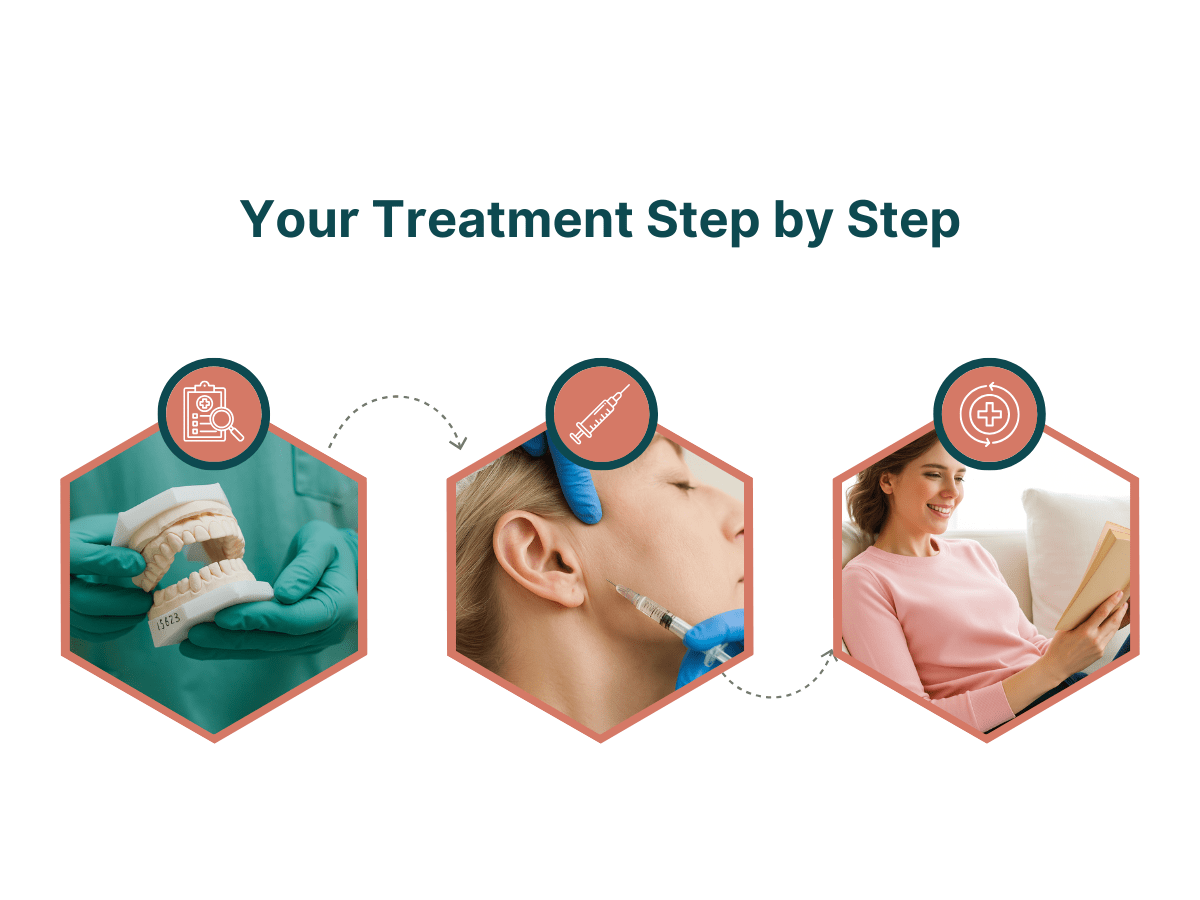Jaw pain, stiff chewing, and morning headaches can wear you down. If you’ve already tried night guards, soft foods, or anti‑inflammatory medication without lasting relief, Botox TMJ treatment may be a gentle next step. This therapy targets overworked jaw muscles to ease clenching, reduce tooth wear, and lower tension headaches often with improvement in just a few days.
At Elizabeth L. Wakim DDS, we carefully evaluate your symptoms using a thorough exam and digital imaging to see if Botox belongs in your personalized TMJ care plan. Our focus is safe, conservative relief that helps you eat, speak, and rest comfortably again.
What Is Botox TMJ Treatment
Temporomandibular joint (TMJ) disorders are more common than many realize, affecting an estimated 5 to 12 percent of adults who experience symptoms that may require treatment. Botox TMJ treatment involves injecting small, precise doses of purified botulinum toxin into the jaw muscles that control biting and chewing. This temporarily relaxes the masseter and temporalis muscles to ease chronic tension, stop clenching and grinding, and reduce the headaches that often accompany TMJ pain. Many adults notice initial improvement within three to five days and the full effect by two weeks.
Botox is FDA approved for medical uses such as chronic migraine prevention and smoothing facial lines. Dentists apply its well-studied muscle-relaxing properties to manage TMJ discomfort safely and effectively. The procedure takes about 10 to 15 minutes with no anesthesia required. You can return to normal activities immediately, and any mild soreness or bruising around injection sites typically clears up within a day or two.
Who Is a Good Candidate
Botox TMJ treatment offers targeted relief for adults with chronic jaw muscle tension and related symptoms. Studies show that Botox injections for temporomandibular joint disorders can reduce pain by 50 to 70 percent within the first month of treatment, along with noticeable improvements in jaw function.
Good candidates include adults who:
- Clench or grind their teeth despite using night guards, oral splints, or stress management techniques
- Experience frequent tension headaches that start in the jaw area
- Notice jaw soreness, stiffness, or enamel wear from overactive masseter and temporalis muscles
This treatment may not be appropriate for patients who:
- Are pregnant or breastfeeding
- Have neuromuscular conditions such as myasthenia gravis or Lambert‑Eaton syndrome
- Have untreated dental infections, active periodontal disease, or severe bite misalignment
Your dentist will perform a thorough evaluation to determine if Botox fits into your personalized TMJ care plan.
How Botox Eases TMJ Symptoms
Botox works by directly relaxing the overactive jaw muscles that drive pain and tension.
Here are the key advantages it offers:
Reduced Muscle Tension
Botox injections use small doses of purified botulinum toxin from Clostridium botulinum to relax the masseter muscle and nearby facial muscles. This helps relieve jaw tension, prevent muscle spasms, and ease discomfort without causing unwanted muscle weakness or paralysis.
Less Teeth Grinding
Relaxing overactive muscles around the temporomandibular joint helps reduce teeth grinding and clenching, two common symptoms of TMJ disorder. This can protect enamel and limit myofascial pain over time.
Fewer Tension Headaches
Tension headaches and neck pain are often linked to tight jaw muscles. A botulinum toxin injection can reduce the pain signals contributing to these issues and help relieve related symptoms.
Improved Jaw Function
When jaw joint stiffness decreases, chewing, speaking, and other daily movements feel more comfortable. This injection method is performed in a doctor’s office and can work alongside other treatments for better results.
Protection for Your Smile
Relaxing the facial muscles involved in TMJ dysfunction helps prevent long-term damage to teeth. Most patients begin to feel relief within a few days, with results lasting up to four months. Botox for TMJ treatment is a safe and effective treatment option for reducing pain and improving quality of life for those with temporomandibular disorders.
What to Expect During Treatment
Botox treatment for temporomandibular joint disorders is a short, in-office procedure designed to provide targeted pain relief with minimal disruption to your day.

- Evaluation and Planning: Your healthcare provider will begin by reviewing your medical history and current TMD symptoms, including jaw tension, chronic facial pain, or related headaches. A physical exam helps identify which facial muscles are contributing to discomfort, typically the masseter and temporalis. For some patients, digital imaging may support a more precise treatment plan.
- The Injection Process: Once the treatment areas are mapped, your provider will inject botox using a very fine needle. Most patients describe the sensation as similar to a small bug bite. Because botulinum toxin treatment involves only small doses, it does not cause muscle paralysis but instead works as a localized muscle relaxant to reduce overactivity in specific muscles. A cold pack may be applied before or after to minimize swelling or soreness.
- After the Visit: There is no required downtime. You can return to normal activities the same day, although you may feel mild tenderness or see slight bruising at the injection sites. These effects usually fade within a day or two. Most patients experience noticeable symptom relief within three to five days, with full improvement in about two weeks.
While Botox is commonly known for cosmetic reasons, its use here is medical. Approved botox formulations are safely used in botulinum toxin therapy to treat TMDs. Your provider will target only the muscles involved in temporo mandibular dysfunction, avoiding any unnecessary impact on other muscles.
Botox may be recommended when splint therapy, physical therapy, or other conservative treatments have not brought lastinRisks and Side Effects
Risks and Side Effects
Botulinum toxin treatment for temporomandibular joint disorders is generally well tolerated, but like any medical procedure, it carries some risks.
Common Side Effects
Most side effects are mild and temporary. These may include:
- Slight swelling or bruising at the injection site
- Temporary chewing weakness, especially when treating the masseter muscle
- Minor soreness or sensitivity in the jaw or nearby facial muscles
Less Common Risks
Rare complications can occur if the botulinum toxin spreads to unintended areas or if the dosage is too high. These may include:
- Uneven muscle activity or facial asymmetry
- Difficulty chewing or speaking if nearby muscles are affected
- Headache or fatigue shortly after treatment
Why Provider Experience Matters
To reduce risks and ensure effective pain relief, it’s important to see a trained healthcare provider who has experience treating TMJ symptoms. A skilled professional will carefully evaluate your symptoms, use approved botox in proper doses, and avoid injecting areas that control important jaw functions.
While complications are uncommon, understanding the potential side effects helps you make an informed decision about treating TMJ with botulinum toxin therapy. As with any procedure involving injections, it’s helpful to know what mild reactions to expect and how to care for the area afterward. You can read more about what healing typically involves in our guide to recovery after oral surgery.
A Safe and Targeted Option for Lasting Relief
For many adults living with temporomandibular joint disorders, Botox treatment offers a safe and effective way to reduce chronic facial pain, ease jaw tension, and improve everyday function. When conservative treatments like splint therapy or physical therapy aren’t enough, botulinum toxin therapy provides a minimally invasive option that works directly at the source of muscle-related TMJ symptoms.
At Elizabeth L. Wakim DDS, we take a thoughtful, patient-centered approach to treating TMJ disorders. Every treatment plan begins with a detailed exam and professional guidance to ensure your care is both comfortable and effective. If you’ve been struggling with TMD symptoms that interfere with your daily life, we’re here to help.
Our team is committed to protecting your smile with gentle, personalized care. If you’re experiencing jaw discomfort, facial pain, or other symptoms of TMJ dysfunction, we’re here to support you. Contact our Pennsylvania office at (724) 558-8222 or use our contact form to schedule a visit and get expert care tailored to your needs.

